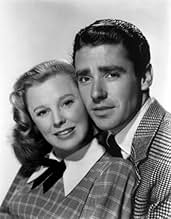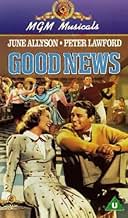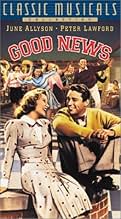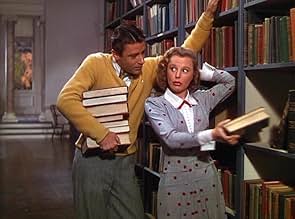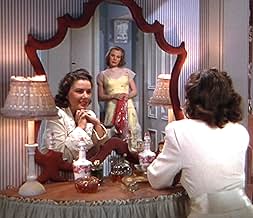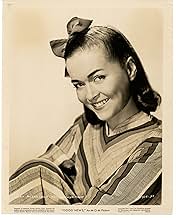IMDb RATING
6.7/10
2.9K
YOUR RATING
Golden Globe winner June Allyson and Peter Lawford star in this enjoyable musical about a football hero who falls in love with his French tutor.Golden Globe winner June Allyson and Peter Lawford star in this enjoyable musical about a football hero who falls in love with his French tutor.Golden Globe winner June Allyson and Peter Lawford star in this enjoyable musical about a football hero who falls in love with his French tutor.
- Nominated for 1 Oscar
- 1 nomination total
Robert E. Strickland
- Peter Van Dyne III
- (as Robert Strickland)
King Baggot
- Man at Coat Check Counter
- (uncredited)
William A. Boardway
- Dance Guest
- (uncredited)
Featured reviews
The musical itself is everything you expect from an MGM musical of the late 1940's - rather light on story and heavy on visual style and good music. I've had the advantage of seeing the original movie musical from 1930, at least what's left of it, which is actually the entire film minus the Technicolor finale. That original has the disadvantage of not having the technical advantages in sound recording and camera mobility. However, the original 1930 movie does have the character of Babe being played by the pixie-like Bessie Love of "Broadway Melody of 1929", and she is every inch the mischievious flapper that Joan McCracken just is not. In fact, the coeds in the 1947 film seem very much like they're from 1947, they're just dressed up in the fashions and driving the cars of the 1920's.
In this film, Connie (June Allyson) is tutoring Tommy (Peter Lawford) in French just as in the 1930 version - except there the subject was astronomy. However, there are two big differences here. In the 1947 film, Lawford's motivation for studying French is to win the affection of a beautiful new student. Also, Tommy knows exactly who Connie is, and their attraction builds slowly. In the 1930 film, the first time Tommy sees Connie she isn't exactly wildly attractive, but she is the best student in the subject at the college. Also, Tommy is already enrolled in French, he is just in danger of failing it and not being able to play in the big game. Also notice in this later film the presence of a very young Mel Torme who seems to be standing in for Cliff Edwards from the 1930 version, complete with ukelele.
In this film, Connie (June Allyson) is tutoring Tommy (Peter Lawford) in French just as in the 1930 version - except there the subject was astronomy. However, there are two big differences here. In the 1947 film, Lawford's motivation for studying French is to win the affection of a beautiful new student. Also, Tommy knows exactly who Connie is, and their attraction builds slowly. In the 1930 film, the first time Tommy sees Connie she isn't exactly wildly attractive, but she is the best student in the subject at the college. Also, Tommy is already enrolled in French, he is just in danger of failing it and not being able to play in the big game. Also notice in this later film the presence of a very young Mel Torme who seems to be standing in for Cliff Edwards from the 1930 version, complete with ukelele.
The chance of waking up at six AM in a semi semiconscious state, flipping on my T.V. and seeing the 1947 film GOOD NEWS, well was such a wonderful surprise. The film of a fantasy life on a college campus sparked me into awaking on a happy positive note. Zany,yes Colorful,yes Lighthearted,yes ESCAPE,yes into a world that seem be be removed from our modern day world. Why shouldn't a Film, Broadway play allow you to slide back into a more comfortable Time and Place? Look theater and the film industry's job is to give us all a place to regenerate our joys and outlook of life. Some how the current films main purpose seems too be,to hang a dark cloud over the populous, retreat into the sanctuary of our home. Times are a changing! and bad in now good. Someone with Intelligence and Knowledge should pick up the script of GOOD NEWS! and run like deer to Broadway in good old N.Y.C. and get this gem on stage. The American public is ripe for some good,happy toe taping fun. I want to leave a theater and feel there is still hope for the human race.....Isn't that what entertaining is all about? But of course the non talented producers seem to not understand the needs of a American Renaissance. Is there something wrong leaving a theater with a smile on your face and a song in your heart". Or is that too plebeian? Lou Sisbarro
Good News was the best musical from the Roaring Twenties from the premier songwriting team of DeSylva,Brown&Henderson. It ran on Broadway for 557 performances in the 1927-29 season and gave the team a number of song hits identified with them like the title song, Just Imagine, Lucky In Love, and The Best Things In Life Are Free. All of those songs made it as well as one of the great dance numbers of the Roaring Twenties, The Varsity Drag.
The musicals of that era had the lightweight nonsensical plots which also was taken from the Broadway show. Big man on campus, Peter Lawford, has to get a passing grade in French to stay eligible for the football squad. He gets mousy student librarian June Allyson assigned as a tutor and the inevitable happens as it does in these films. After that Lawford has to choose between mercenary coed Patricia Marshall and Allyson. It's a struggle, but you guess who he winds up with.
This film is strictly about the music and dance numbers and it offers a rare opportunity to see Joan McCracken singing and dancing which she mostly did on the Broadway stage. She introduces a song especially written for the film Pass That Peace Pipe which was a big hit in 1947 and won for Good News its only Academy Award nomination. Pass That Peace Pipe lost to Zip-A-Dee-Doo-Dah for Best Song. But the number is one of the best dance numbers ever to come from an Arthur Freed produced MGM musical. Joan McCracken died way too young as oddly enough her dancing partner Ray McDonald.
Good News presents an idealized version of the Roaring Twenties and is the quintessential college musical which flooded Hollywood mostly in the years before World War II. It holds up well as entertainment and the songs are still fabulous.
The musicals of that era had the lightweight nonsensical plots which also was taken from the Broadway show. Big man on campus, Peter Lawford, has to get a passing grade in French to stay eligible for the football squad. He gets mousy student librarian June Allyson assigned as a tutor and the inevitable happens as it does in these films. After that Lawford has to choose between mercenary coed Patricia Marshall and Allyson. It's a struggle, but you guess who he winds up with.
This film is strictly about the music and dance numbers and it offers a rare opportunity to see Joan McCracken singing and dancing which she mostly did on the Broadway stage. She introduces a song especially written for the film Pass That Peace Pipe which was a big hit in 1947 and won for Good News its only Academy Award nomination. Pass That Peace Pipe lost to Zip-A-Dee-Doo-Dah for Best Song. But the number is one of the best dance numbers ever to come from an Arthur Freed produced MGM musical. Joan McCracken died way too young as oddly enough her dancing partner Ray McDonald.
Good News presents an idealized version of the Roaring Twenties and is the quintessential college musical which flooded Hollywood mostly in the years before World War II. It holds up well as entertainment and the songs are still fabulous.
There are definitely better musicals than 'Good News' made before, during and since. That doesn't matter, because although it has imperfections it is still a delight in so many ways.
Starting with 'Good News' problems, it is agreed that the scene with Connie Gilchrist is overwritten and overacted (in fact, some of the humour is tiresomely flat) and that the football scene is overlong and drags. It is also a shame that Mel Torme, by far the best singer in the cast, has very little to do, a singer of his calibre deserves better than that.
On the other hand, 'Good News' is very lavishly produced. It is true that the costumes and hair-styles are more 1940s than 1920s, but they do look lovely, and numbers like "Pass that Peace Pipe" and "Varsity Drag" are filmed beautifully. The music is wonderful, especially "Pass that Peace Pipe", "Varsity Drag", the title number, "Imagine" and the most famous song "The Best Things in Life are Free". "The French Lesson" is very funny as well. The choreography similarly dazzles, especially in "Pass that Peace Pipe" and "Varsity Drag", which are two of the energetic musical numbers of the 40s.
Charles Walters directs excellently, hard to believe that this was his directorial debut. The script is mostly very amusing and fills the heart with warmth, the film crackles with energy and while the story is fluffy and predictable admittedly it is also light-hearted, heart-warming and charming with solid pacing, also not being as contrived or corny as some musicals' stories were.
June Allyson has a role that fits her to the bone and it shows off her personality and strengths so well. She sings "Imagine" touchingly wistfully. Am not usually a fan of Peter Lawford, but while his singing is only adequate if even that he does give some charm to a rather caddish character and his dancing looks more comfortable than in other musicals he participated in. He and Allyson sparkle together, especially in "The French Lesson", even if they are too old to pass for college students. Joan McCracken is crackling fun that it beggars belief that her career wasn't bigger.
In conclusion, has flaws but 'Good News' is a delight on the most part. 8/10 Bethany Cox
Starting with 'Good News' problems, it is agreed that the scene with Connie Gilchrist is overwritten and overacted (in fact, some of the humour is tiresomely flat) and that the football scene is overlong and drags. It is also a shame that Mel Torme, by far the best singer in the cast, has very little to do, a singer of his calibre deserves better than that.
On the other hand, 'Good News' is very lavishly produced. It is true that the costumes and hair-styles are more 1940s than 1920s, but they do look lovely, and numbers like "Pass that Peace Pipe" and "Varsity Drag" are filmed beautifully. The music is wonderful, especially "Pass that Peace Pipe", "Varsity Drag", the title number, "Imagine" and the most famous song "The Best Things in Life are Free". "The French Lesson" is very funny as well. The choreography similarly dazzles, especially in "Pass that Peace Pipe" and "Varsity Drag", which are two of the energetic musical numbers of the 40s.
Charles Walters directs excellently, hard to believe that this was his directorial debut. The script is mostly very amusing and fills the heart with warmth, the film crackles with energy and while the story is fluffy and predictable admittedly it is also light-hearted, heart-warming and charming with solid pacing, also not being as contrived or corny as some musicals' stories were.
June Allyson has a role that fits her to the bone and it shows off her personality and strengths so well. She sings "Imagine" touchingly wistfully. Am not usually a fan of Peter Lawford, but while his singing is only adequate if even that he does give some charm to a rather caddish character and his dancing looks more comfortable than in other musicals he participated in. He and Allyson sparkle together, especially in "The French Lesson", even if they are too old to pass for college students. Joan McCracken is crackling fun that it beggars belief that her career wasn't bigger.
In conclusion, has flaws but 'Good News' is a delight on the most part. 8/10 Bethany Cox
This movie and other MGM musicals in particular should be viewed by anyone who thinks they want to produce a film musical today. Watch the Pass That Piece Pipe number and the Varsity drag. Pretend you are the camera and take note of the long uninterrupted takes and the fluid motion of the dancing in concert with the camera. Then look at the musical numbers from Chicago . . . where all they did was cheat and all the action was produced in the cutting room . . the skill is gone. It is a lost art, along with dancing which has been replaced by callesthenics.
Also, if you look closely to the left of the screen in the early part of The Varsity Drag, you will see one of the dancers hold her head and drop to the floor. She does not reappear in the remainder of the shot. June and Peter are the perfect couple and he is totally light on his feet unlike Richard Gere who was so lauded for being a non-dancer who was now "dancing" . . . ha! Now Peter was actually a non-dancer who was dancing and doing a good job of it without cheating, just as Frank Sinatra did in Take Me Out to the Ballgame.
Also, if you look closely to the left of the screen in the early part of The Varsity Drag, you will see one of the dancers hold her head and drop to the floor. She does not reappear in the remainder of the shot. June and Peter are the perfect couple and he is totally light on his feet unlike Richard Gere who was so lauded for being a non-dancer who was now "dancing" . . . ha! Now Peter was actually a non-dancer who was dancing and doing a good job of it without cheating, just as Frank Sinatra did in Take Me Out to the Ballgame.
Did you know
- TriviaSince Peter Lawford spoke French fluently and June Allyson did not, Lawford had to teach Allyson how to teach him to speak French in "The French Lesson" scene.
- GoofsDuring the "Varsity Drag" musical number, one of the chorus girls is accidentally pushed out of step.
Possibly (even likely) intentional as non-professional (i.e., high school, college) productions are rarely perfectly performed.
- Quotes
Pooch: Come on, Bobby, get your uniform off.
Bobby Turner: Aw, gee, Poochy. I get so little chance to wear it I like to keep it on until the last minute. Sometimes I even rub a little dirt on it just to convince myself I'm really on the team.
- ConnectionsFeatured in MGM Parade: Episode #1.4 (1955)
- SoundtracksGood News
(uncredited)
Music by Ray Henderson
Lyrics by Lew Brown and Buddy G. DeSylva
Sung by Joan McCracken and chorus
- How long is Good News?Powered by Alexa
Details
Box office
- Budget
- $1,662,718 (estimated)
- Runtime
- 1h 33m(93 min)
- Aspect ratio
- 1.37 : 1
Contribute to this page
Suggest an edit or add missing content


